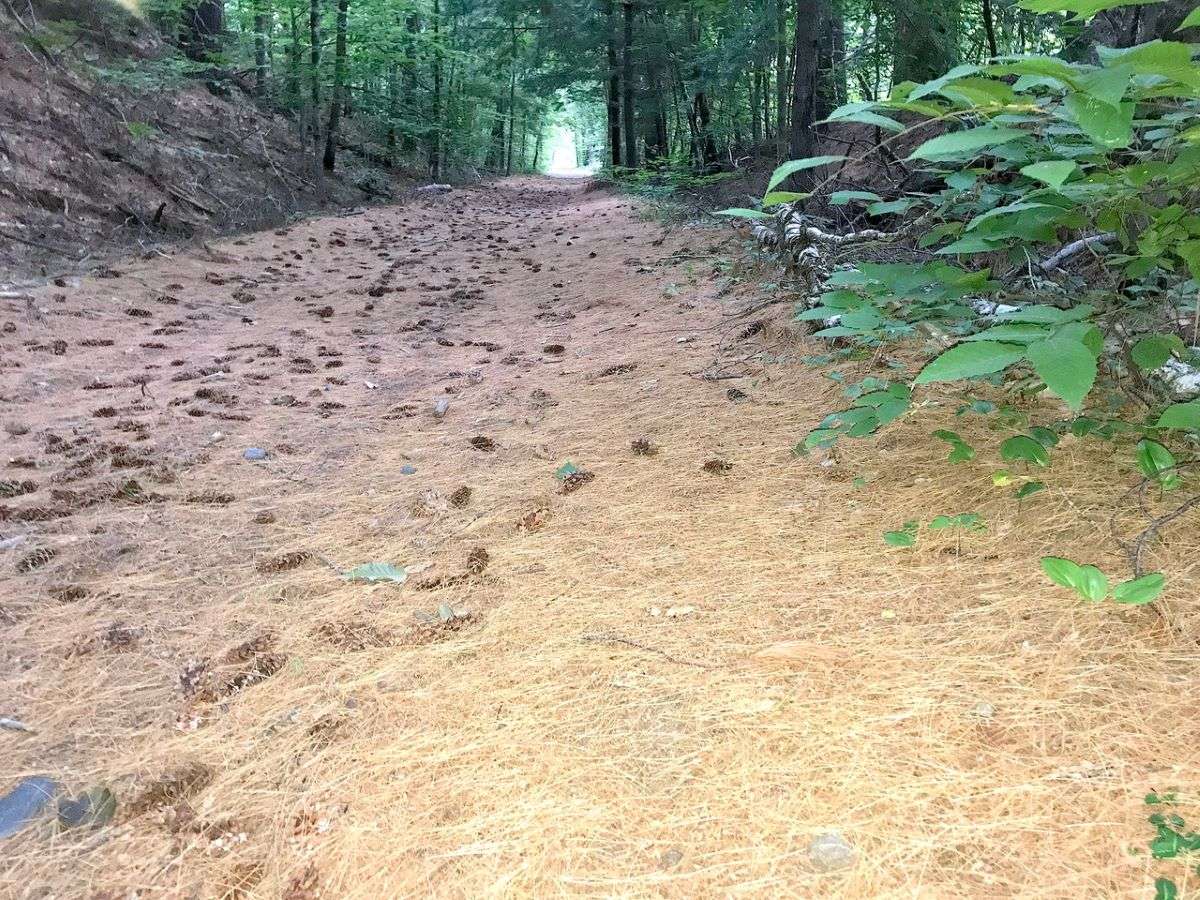Out in the Woods
- July 19th 2024
- Out in the Woods

White pine needle disease is evidenced by the yellow/brown needles along Sanford’s Rail Trail. Also notice the remnants of last year’s mast year of pinecones.
That Cushion of Pine Needles Spells Trouble
Photo: Kevin McKeon
By Kevin McKeon, Maine Master Naturalist
During a recent Mousam Way Land Trust workday, as several volunteers were preparing the greenhouse for its first plastic cover installation, the friendly chatter morphed into a discussion about why our trails are covered in pine needles this summer. The answer, according to core volunteer Dr. Bud Johnston – white pine needle disease. Since this phenomenon is currently widespread along our trails and in other parts of New England, this might be a good time to investigate.
In the spring of 2010, almost 100 square miles of pine trees in Maine were found to be dropping needles from their crowns, concerning both landowners and businesses. Since white pine is an essential economic and ecological species not only to Maine, but to much of the northern US and eastern Canada, this was a serious issue. So, in 2011, the USDA Forest Service coordinated a survey with forest health state cooperators from Maine, New Hampshire, and Vermont to investigate the cause of the needle damage. The needle loss from the disease was noted as causing thinning crowns in pine trees of all ages. The primary cause was found to be fungi that flourished during the previous wet spring and summer.
But there are many other causes for premature needle drop on our pine trees. Climate change is causing a condition in our white pines’ soil. The topsoil remains relatively warm due to many freeze/thaw cycles, while the subsoil remains frozen. This makes the pine, a shallow-rooted tree, think that the time for its winter sleep isn’t here yet. It wants to retain its summer level of water intake, but is unable to tap into the deeper, frozen water, so the tree gets thirsty, or dehydrated. Drought, pests, fungi, and road salt are some other culprits. All these actions cause stress, leading trees to shed needles that are no longer properly functioning. Foliar, or leaf-related, diseases alone are rarely lethal to forest and landscape trees, but they create chronic and compounding stresses as needles are killed and stress is the door through which other, more destructive villains gain entry.
Climate change has transformed our regional weather patterns, bringing early rains and increased humidity — prime fungal habitat. White pine needle disease is caused by four fungi in particular. Studies seem to indicate that three fungi could be the stressors that initially weaken the pine (along with the above-mentioned reasons), and the fourth fungus has been recently identified as the widespread culprit for the current yellow/brown pine needles dropping all over New England.
Last year’s very wet season created favorable conditions for fungi to attack pine trees, but it takes a year for the fungus to strangle the needle, causing it to turn yellow/brown and fall off. So, the needles we see on the trails now are the product of last year’s fungal actions. Also, needles normally live for two years, so while the pine is naturally losing its two-year-old needles, the fungus is killing the one-year-old needles. This creates a heavy stress on the tree’s ability to make food (with its needles via photosynthesis) for this year. The fungi remain on the needles, reproducing via spores which disperse into the environment from minute eruptions on the needles — needles that are still on the tree and also on the ground. As they fall, some needles get stuck among other needles and branches, causing more spore-spreading. Wind and rain help to disperse the spores to other trees, and to other needles on the infected tree, making this an insidious infection to quell.
In a Maine Public Radio publication, Maine Forest Service Pathologist Bill Ostrofsky says this epidemic has been under the watchful eyes of scientists, and after eight years some of the weakest trees have died. He goes on to say, “We suspect that most of the trees will survive, and with any luck, we’ll get a break in the weather pattern, or whatever it is, that has triggered this.”
As Ostrofsky suggests, the exact causes of white pine needle disease are murky. They may very well be the culmination of various elements. Addressing this defoliation disease may require a many-pronged attack, but climate change is increasingly becoming the issue of highest importance to recognize and fix, for us humans as well as our friends, the pine trees.
Editor’s note: Did you see something unusual last time you were out in the woods? Were you puzzled or surprised by something you saw? Ask our “Out in the Woods” columnist Kevin McKeon. He’ll be happy to investigate and try to answer your questions. Email him directly at: kpm@metrocast.net






